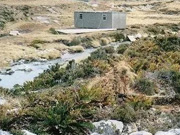

IV. Building and Maintenance of Nuclear Emergency Capabilities
Sticking to the guidelines of versatile compatibility, resource integration, interdisciplinary support, and integration of military and civilian capabilities, China builds and maintains national nuclear emergency capabilities commensurate with the safe and efficient development of nuclear energy, and forms a fully-fledged national system of nuclear emergency response capabilities.
At the national level, a unified nuclear emergency response capabilities system is in place to coordinate military and local systems whereby three distinct tiers of capabilities are maintained, viz. national, provincial and nuclear installation operator levels, with a view to pushing forward with the building of various capabilities related to nuclear emergency response.
Building national nuclear emergency response professional technical support centers. China has built eight types of national-level nuclear emergency technical support centers, i.e., radiation monitoring, radiation prevention, aviation monitoring, medical rescue, marine radiation monitoring, meteorological monitoring and forecasting, decision-making aid, and response action, along with three national-level nuclear emergency response training bases, thereby essentially forming an integrated emergency technical support and training system featuring a full array of disciplines and functions, and effective support.
Building national-level nuclear emergency rescue forces. Through efforts over many years, China has already built a specialized nuclear emergency rescue capability system that is of a proper scale, well-coordinated and of a rational layout. To cater to the needs of layout for the construction of nuclear power stations, on the principle of regional deployment, modular set-up and disciplinary integration, over 30 national-level professional rescue teams have been formed to specifically take charge of various kinds of specialized rescue missions. The military constitutes an important part of the national-level nuclear emergency rescue force, and fulfills the mission of aiding local nuclear accident emergency response actions, and, as such, has scored brilliant achievements in building up its nuclear emergency response capabilities. To cope with possible severe nuclear accidents and on the basis of the available capabilities, China is to form a national nuclear emergency rescue team composed of over 300 people to be mainly responsible for undertaking unexpected rescue missions in serious nuclear accident scenarios and emergency treatment tasks, and stand ready to take part in international nuclear emergency rescue operations.
Building provincial-level nuclear emergency rescue forces. Nuclear emergency response forces have been established at the provincial (regional and municipal) levels in areas where nuclear power stations are sited, including nuclear emergency command centers, emergency radiation monitoring networks, medical treatment networks, meteorological monitoring networks, decontamination points, evacuation roads and shelters for evacuees, along with specialized technical support and rescue task forces, thereby basically meeting the nuclear emergency preparedness and response needs of the involved regions. Each provincial (regional and municipal) nuclear emergency command center is connected with the nuclear installation(s) within its jurisdiction.
Building a nuclear emergency response force on the part of the operators of nuclear installations. In accordance with national requirements and following international standards, operators of nuclear installations in China have set up their own nuclear emergency response facilities and forces, including emergency command centers, emergency communication facilities, and emergency monitoring and consequence evaluation facilities. In addition, emergency facilities, equipment and instrumentation, such as emergency power supply, are in place. On-site rescue teams specializing in radiation monitoring, accident control, decontamination and cleansing have been established. Corporations controlling operators of the respective nuclear installations have set up a mutual support collaborative mechanism to form nuclear emergency response resource reserve and deployment assistance capabilities, thereby ensuring mutually complementary support and coordination.
In accordance with the principle of versatile compatibility and based on their respective duties and responsibilities, government departments at different levels in China have established and reinforced their respective capability systems to serve and safeguard nuclear emergency response activities commensurate with the tasks established under the National Nuclear Emergency Plan.
In accordance with the nuclear emergency response plans worked out by the national and provincial (regional and municipal) authorities and the operators of nuclear installations and within the institutional framework of the national nuclear emergency response system, various levels and categories of nuclear emergency response forces ensure unified deployment and interactive mobilization to jointly undertake tasks associated with nuclear accident emergency situations.
 |  |
Day|Week

 Beautiful Chinese tennis player Wang Qiang goes viral online
Beautiful Chinese tennis player Wang Qiang goes viral online Chinese pole dancing master opens class in Tianjin
Chinese pole dancing master opens class in Tianjin The most beautiful town of snow in China
The most beautiful town of snow in China SWAT members hold romantic wedding in E China
SWAT members hold romantic wedding in E China Breathtaking scenery and simple lifestyle in Hainan
Breathtaking scenery and simple lifestyle in Hainan Finding sexiest underwear supermodels
Finding sexiest underwear supermodels Top 10 ancient pagodas in China
Top 10 ancient pagodas in China Chinese version of Victoria's Secret Show held in Hunan
Chinese version of Victoria's Secret Show held in Hunan Can you find out the sniper hiding in camouflage?
Can you find out the sniper hiding in camouflage? Spectacular rockets launch scenes
Spectacular rockets launch scenes